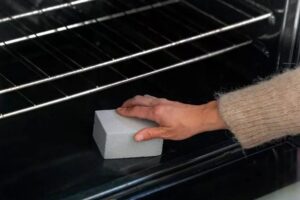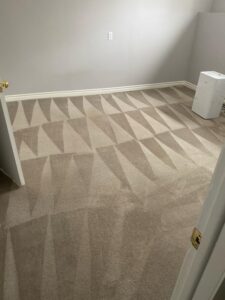
“I’d rather my home reflect my personal style and make me feel good, versus living in a space with white walls and no artwork,” says Ramsey, who’s lived in the same Los Angeles apartment for the past four years, during which she’s covered most of the walls with murals and designs. “I often joke that my apartment is like a selfie emporium,” she says. Because it often serves as the backdrop for her videos, “I always want it to be colorful and interesting and my style is very mixed prints, bold. I love shapes, I love engaging patterns, I love circles, and so my apartment reflects that.”
While many renters have taken up Ramsey’s song as an anthem, she has also heard from a slew of critics. “I got so many messages from people that were like, if you want to paint, buy your own property, and like, I would love to buy my own property. That was my plan. That’s what I wanted to do,” she says. But rocketing housing prices and a tight market mean that’s simply not in the cards for her at the moment. “So instead of living in a white prison, I’m just going to paint where I live now and make the best of it.”
Ramsey’s perspective reflects that of many current renters — shut out of the housing market but unwilling to wait to live somewhere that expresses their personal style and feels like a real home. With a little elbow grease and help from YouTube tutorials, they’ve decided to modify their rental spaces instead. In the process, a lot of them have developed major followings and even livelihoods by posting their renovations on social media.
For many of them, the pandemic was a tipping point. “I went from being a person who was almost never home to being a person who was always home,” says Imani Keal, who rents in D.C. “I hated my apartment because it was ugly … I felt like the walls were closing in on me.” To escape, she would take long walks and end up at the local hardware store, where she started buying the materials to upgrade her space.
She began posting her projects on Instagram — installing wraparound floating shelves or painting her studio apartment black — and watched her follower count grow steadily.
“You may not want to do what I did. I get it, painting your house black is not for everybody,” says Keal. “But it’s an option. It’s showing you that something is possible. … All I want to do is show people that things are possible, that you can do cool stuff and it doesn’t have to kill your bank account.
Keal kept hearing from people who wanted to decorate, but were afraid of getting in trouble with their landlord. So, she wrote a template letter for renters to send to their landlords, based on the note she used to get permission from hers. “Since moving in, I’ve been a model tenant and believe these upgrades would benefit you in the long run,” it reads, in part. It’s been downloaded more than 3,000 times.
The stakes are anything but superficial to her. “How your house looks and feels impacts how you look and feel, and how you act in the world,” she says. “I know people who don’t build relationships because they don’t invite people over to their homes.”
Keal, who used to juggle multiple jobs, including at restaurants and a luxury kitchen and bath store, has since become a full-time content creator; she has partnerships with brands such as Ikea and Otto Studio. She’s gotten used to brushing off online commenters who say her renovations are a waste of money. “If you [spent] ten grand [to] go on a great vacation so that you could enjoy 10 days out of the 365 days in a year, no one would question you. No one would say, ‘Oh, that’s stupid,’” she says. “But if I take ten grand … and decorate the place I walk around in every single day, all of a sudden, ‘Oh, you’re losing money.’ It’s ridiculous.”
Los Angeles renter Marco Zamora has never let a living situation’s temporary status get in the way of his creative vision. While studying civil engineering in college, for each year’s dorm room, “I made an entire theme and designed it completely different,” he says. “However long I was going to be there, I wanted it to feel special, and I wanted it to feel like it was mine.”
Now, for his more than 1 million social media followers, he focuses on renter-savvy decor, such as a bed canopy constructed from fabric, curtain rods, hooks and a chain, or adding a door frame with a Mexico City-inspired stained glass transom window. His previously all-white kitchen underwent a total metamorphosis when he added red peel-and-stick tile that mimics vintage marmoleum to the floor, faux-wood contact paper to the countertops and new light fixtures along with a ceiling medallion — all chosen for aesthetics and the ability to be undone if he moves.
Because for renters, an eventual move is a near certainty. Linny Giffin and Claire Keane, the duo behind design service and virtual community House Friends, encourage renters to spend wisely. Big-ticket items, they say, should be things they can bring with them to their next stop, such as furniture, art and light fixtures. They dub their approach “building your collection” — purchasing items with a curatorial eye, so that you’re surrounded by what you love and what feels like home to you.
Keane is currently deploying that strategy herself, after a recent move to a rental duplex in Teaneck, N.J., with her husband and toddler. She’s tackling the living room and her son’s room first, both areas where the family will spend a lot of time. Her strategy is to find as much as she can secondhand in the first few weeks, then fill in wherever necessary with new pieces from sources such as Ikea.
One quirk of the duplex is that the walls are a strange texture, so she doesn’t plan to paint them. Instead, she’ll search for bright furniture and use fun fabrics for window coverings. But the idea of just letting the temporary home sit undecorated is simply not an option.
“If you wait for your quote-unquote ‘forever home,’ we’re all going to be waiting forever,” says Keane. “You’ve got to prioritize feeling good and feeling happy in your home at every stage.”
correction
An earlier version of this story misspelled the last name of Linny Giffin, one half of the duo behind the design service and virtual community House Friends. This version has been corrected.




